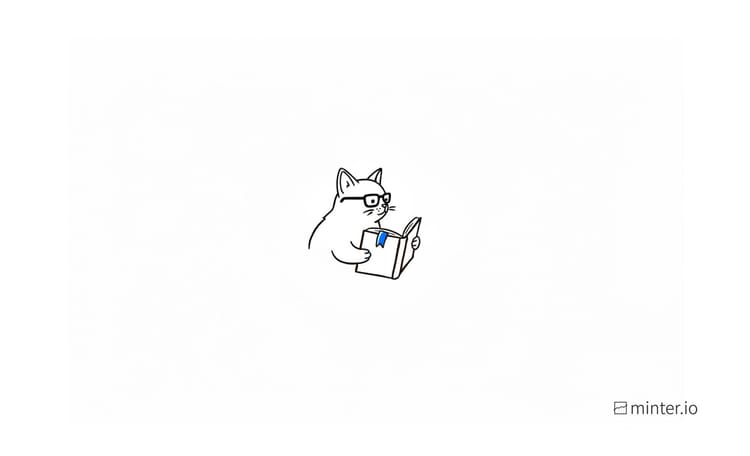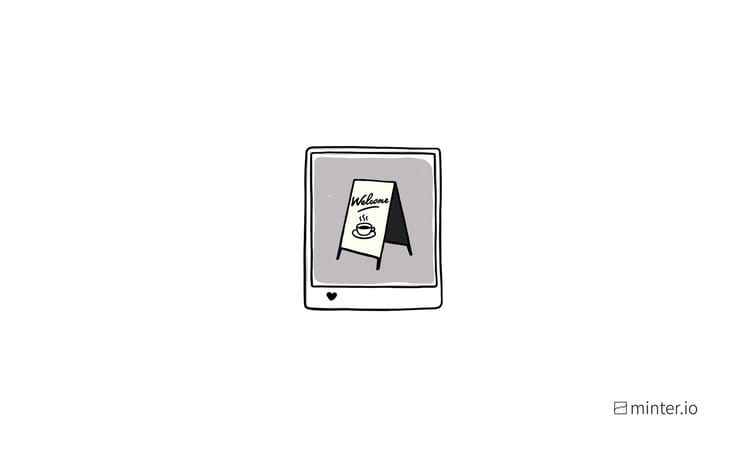How ClickUp went from zero to millions of views on TikTok

Feeling like your TikTok content isn't getting the amount of attention and engagement you want it to? This is the article for you. We’re diving into ClickUp’s TikTok account to show you how it went from tragic to triumphant with a little know-how and a lot of trial and error. It took a bit of time for ClickUp to figure out what worked for its brand - and that’s ok! Now ClickUp is reaping the benefits of a thriving TikTok presence, and you can learn how they did it to make immediate changes and get some wins.
So, how exactly did ClickUp go from getting a few likes and views per video to getting viral hits with millions of likes and views?
It started by addressing 3 key problems…
Problem 1: Content that felt like ads
When ClickUp started its TikTok account, it leaned into showing off its product and mentioning all the ways it was useful. This might seem like a logical way for a business to approach social media marketing, but it’s far from the most effective approach, especially when you have a relatively unknown business.
ClickUp promoted its product by putting it in sketches, inserting it into trends and even getting a rapper to spit beats about the product while wearing a ClickUp t-shirt. The issue was that this made every TikTok video feel like an ad; it all felt a bit corporate and stuffy and, as a result, a lot of the content flopped.
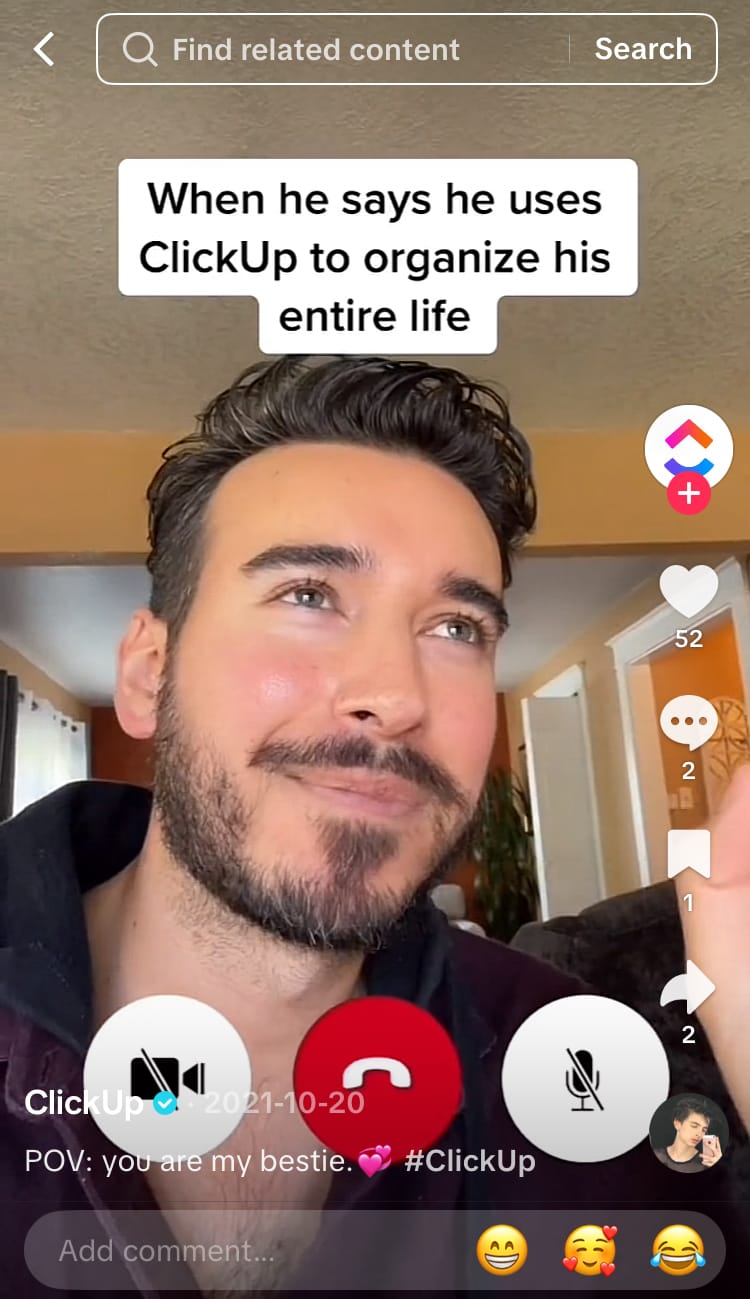

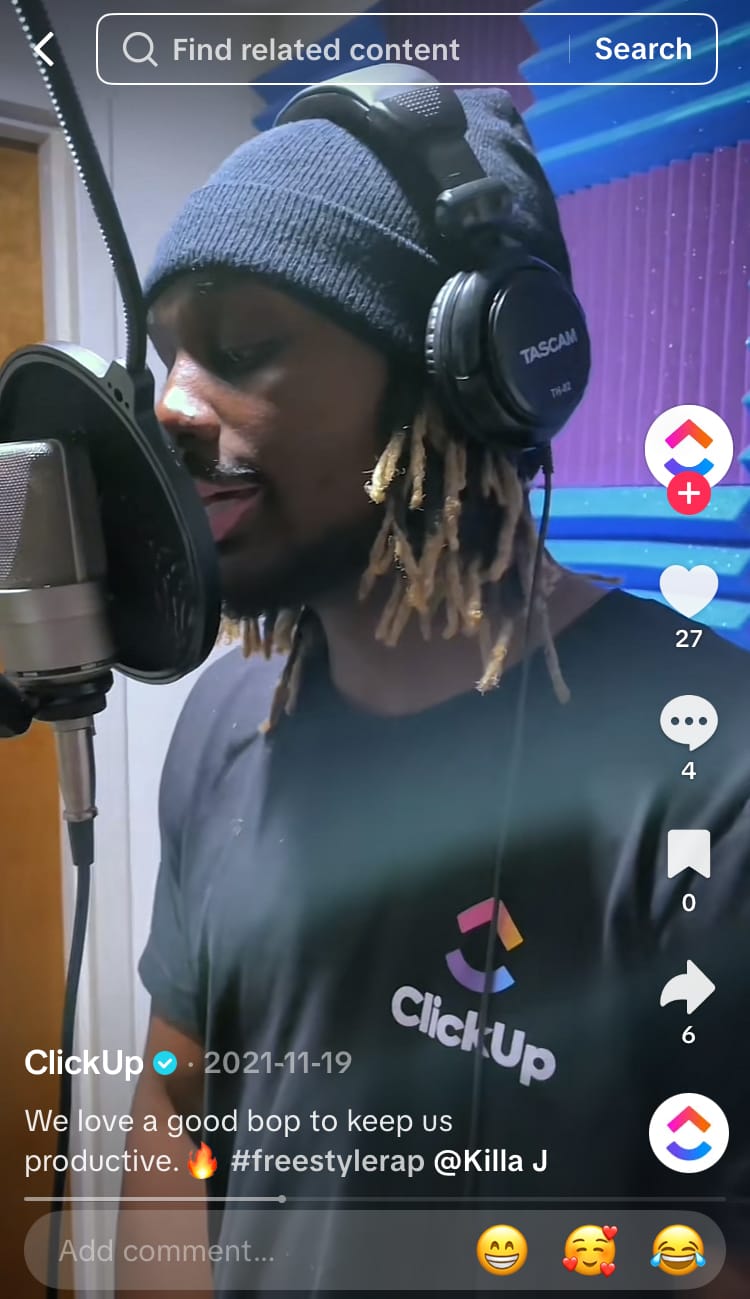
TikTok videos by ClickUp
When you put your products or services as the focus of your TikTok content, especially if you don’t yet have an established brand or a well-known business, you run the risk of your content feeling pushy. After all, no-one wants to feel like a walking wallet.
Solution: Ditch promotional content
Would you watch TV if it was a stream of adverts with no entertainment in the middle? Of course not! Try to think of social media in the same way. The main bulk of content should give the audience some kind of reward. It should be valuable to the viewer in some way and they should want to watch it and choose to watch it. No-one is forced to follow a brand on TikTok, so you need to give people a good reason to stick around.
When ClickUp pivoted from promotional content to entertainment, it gave people something to connect with and want to stick around for. Instead of focusing on showcasing the product, ClickUp shifted its focus towards fostering connection and community through humour. Because what does a person stuck doing 9-5 in an office value? A good laugh and a mental break. Maybe a nap and a coffee too, but there’s only so much you can do through social media.
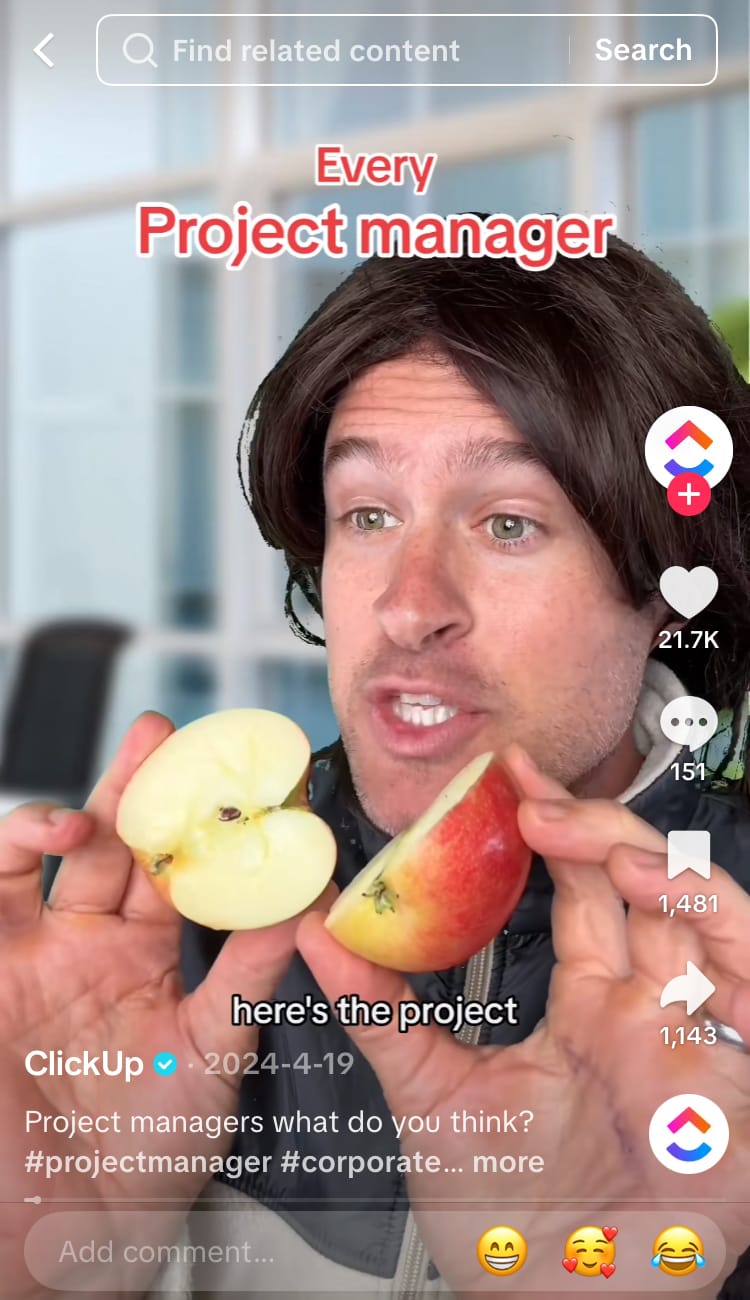
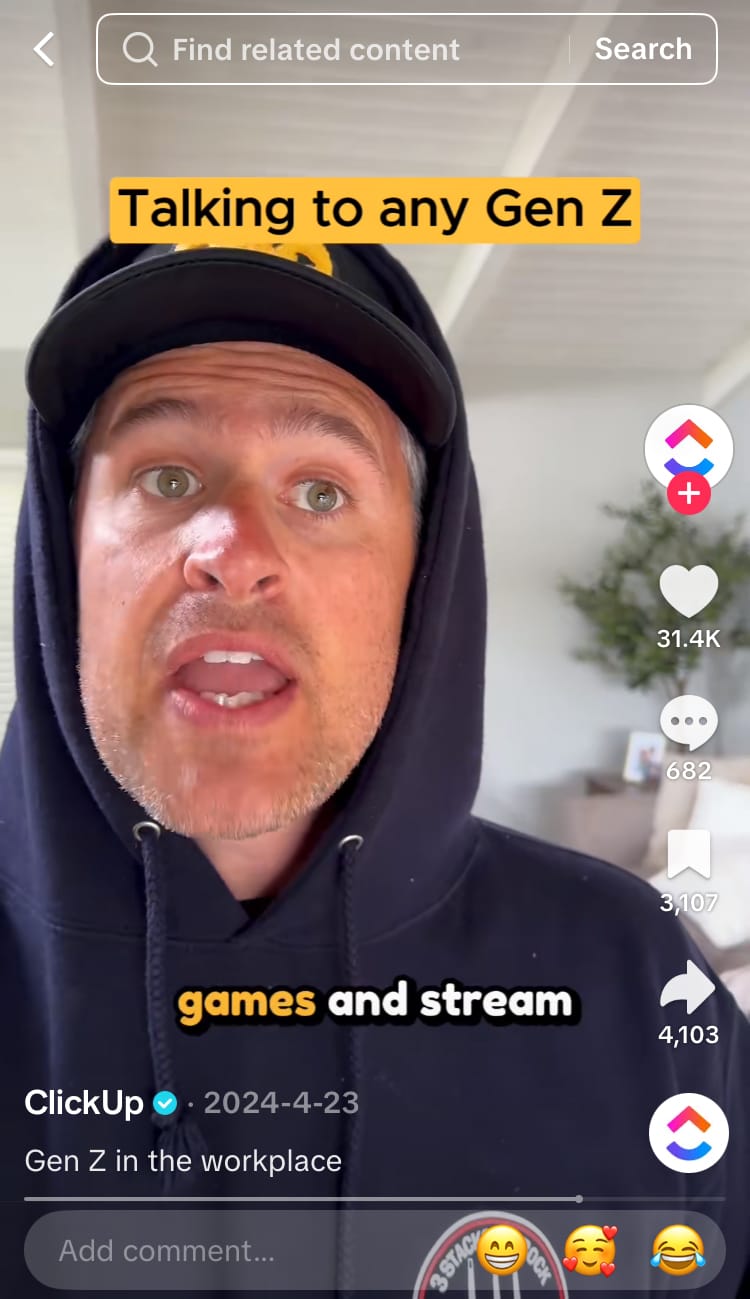
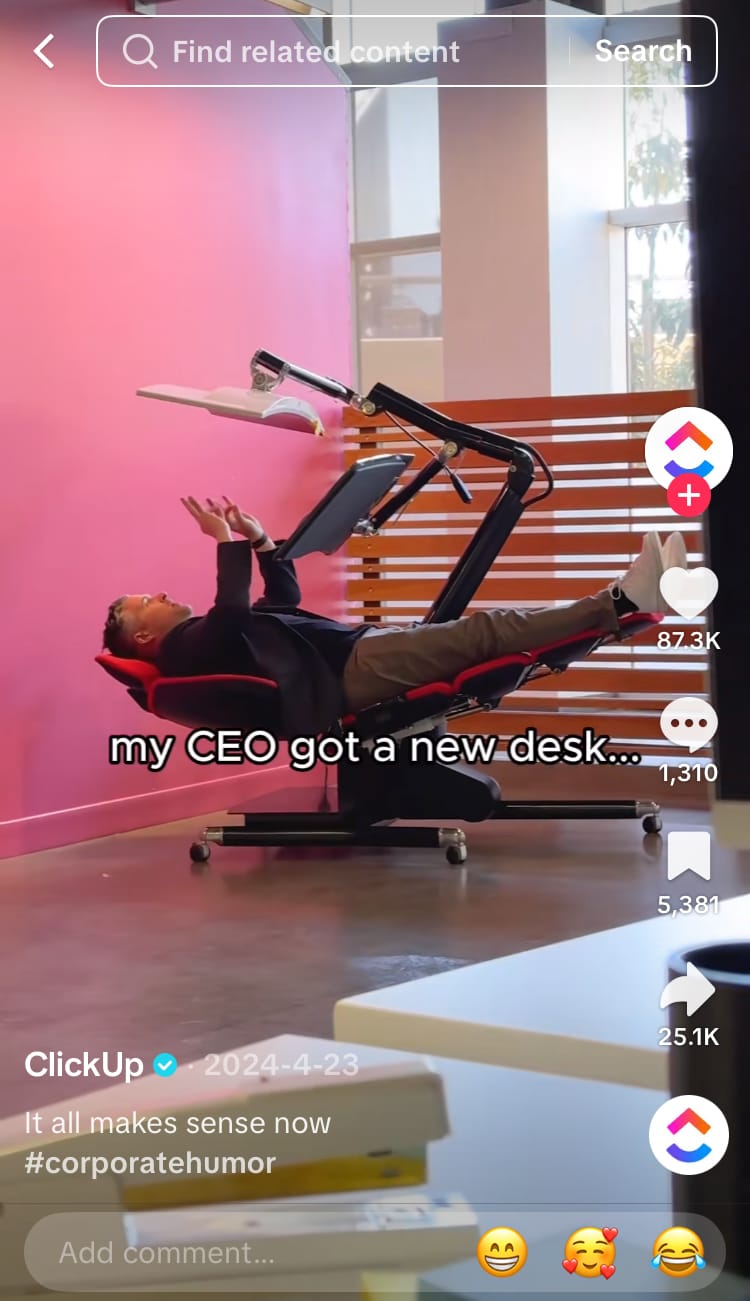
TikTok videos by ClickUp
ClickUp’s change in approach put the customer experience at the centre of the content, giving people a reason to continue returning to the ClickUp profile. While building connections through comedy, ClickUp builds trust with viewers. Over time viewers grow the desire to discover more about the brand and seek out products and services for themselves. That’s the power of indirect marketing!
Problem 2: No clear direction
After realising that a promotional approach was getting lacklustre results, ClickUp started to throw a lot of stuff at the wall to see what sticks. The result? An incohesive jumble of ideas that didn't work very well together.
Was the next ClickUp TikTok video going to be centred around productivity tips, daily routines, workplace sketches, other businesses, famous people, interviews about their content strategy or inspirational quotes? Well, it could be any one of those things… and therein lies the problem. If you followed ClickUp’s TikTok account, you had no idea what you were signing up for.
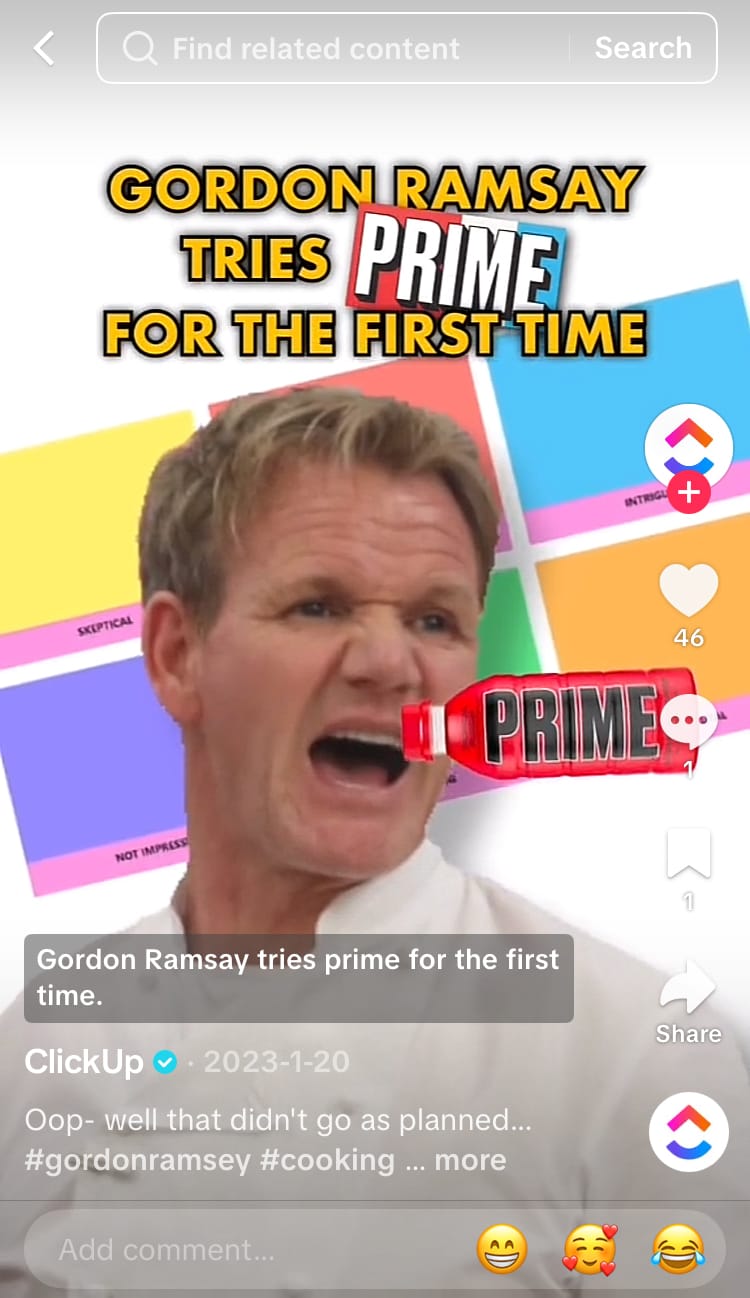


TikTok videos by ClickUp
With ClickUp’s topics and approach changing regularly, it was difficult to build a community of people and get a consistent amount of views and engagement. It’s hard for people to connect with a vision, a style and a message if it appears to be constantly changing. Unfortunately, trying to appeal to a vast and vague group of people often leads to no-one taking the bait. By trying to appeal to everyone, they appealed to basically no-one.
Solution: Find and cater to your true audience
To fix the direction of the content, ClickUp had to get super clear on the audience it needed to connect with and figure out how best to do that. ClickUp first attempted to nestle into the productivity niche, but that also failed to hit because it didn’t completely fit the people who use the product. The truth is, people using a productivity tool aren’t necessarily looking to be hyper-focused on productivity; they’re simply trying to make their lives easier. ClickUp would have to recognise this before it could build the solid audience it has today.
In the end, the content that really popped off connected with everyday people working regular office jobs. It noticed Jan in accounting, waiting for 5pm to hit so she could have cocktails with the girls. It vibed with Dave in the finance department, looking forward to being silly with his mate Bill. It gave a spotlight to Armando bragging about his recent trip to Rome to bored receptionist Grace who's welcoming the distraction.
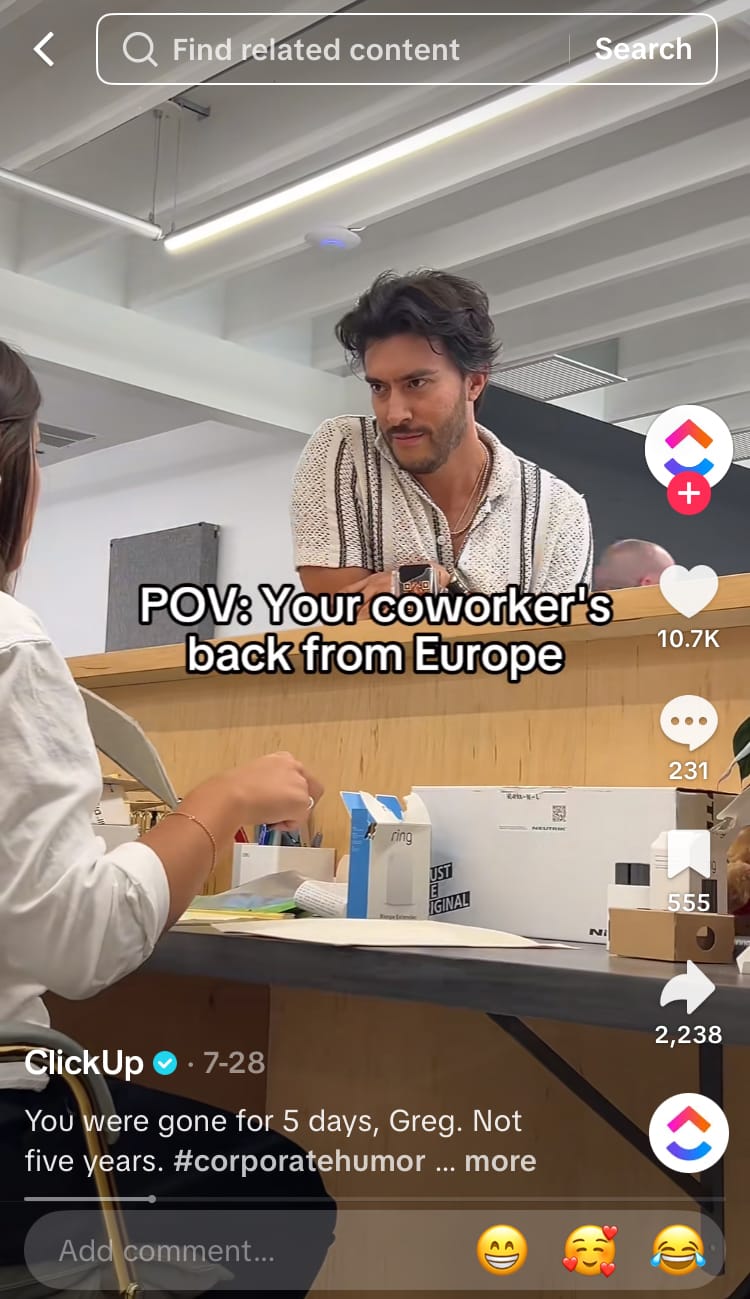
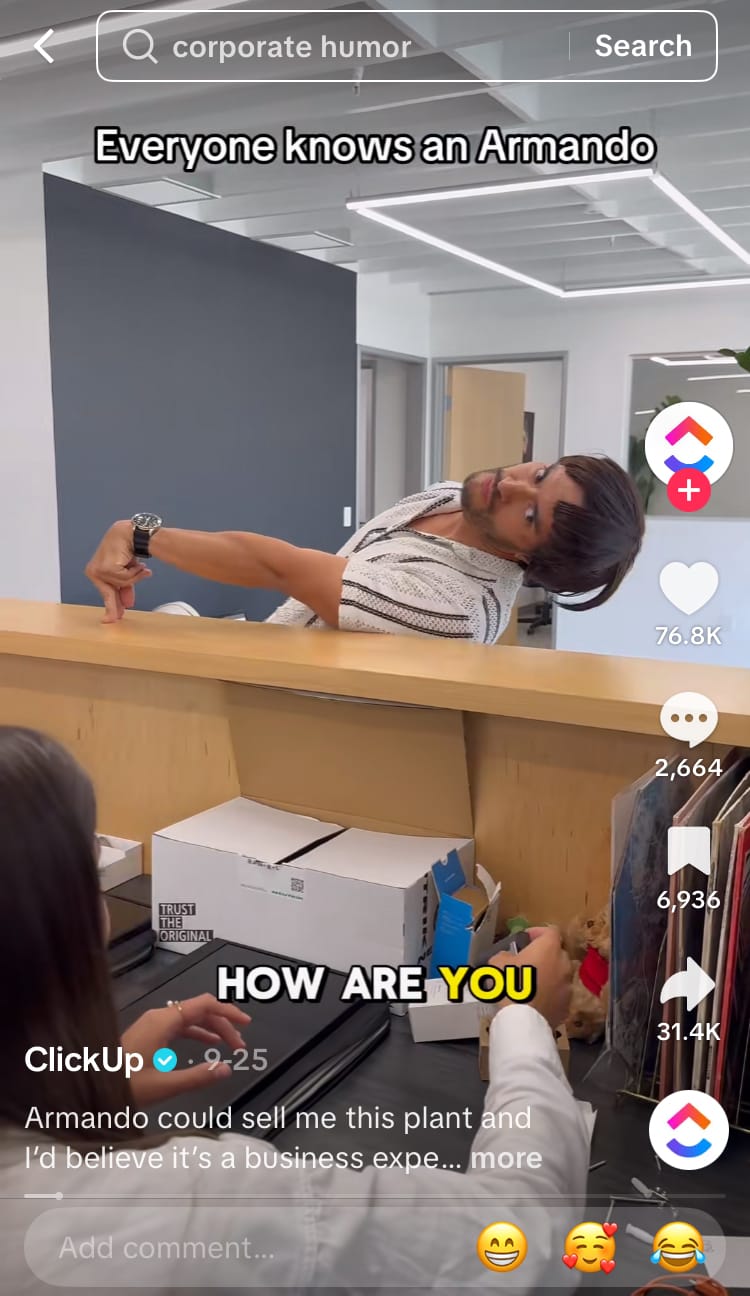
TikTok videos by ClickUp
When ClickUp humanised its approach, and made its content relatable to the everyday person in an office environment, its content gained traction and its community started growing quickly. Why? Because more people could see themselves, their friends and their coworkers in the skits. This made the content far easier and more enjoyable to watch, like, comment on and share with others.
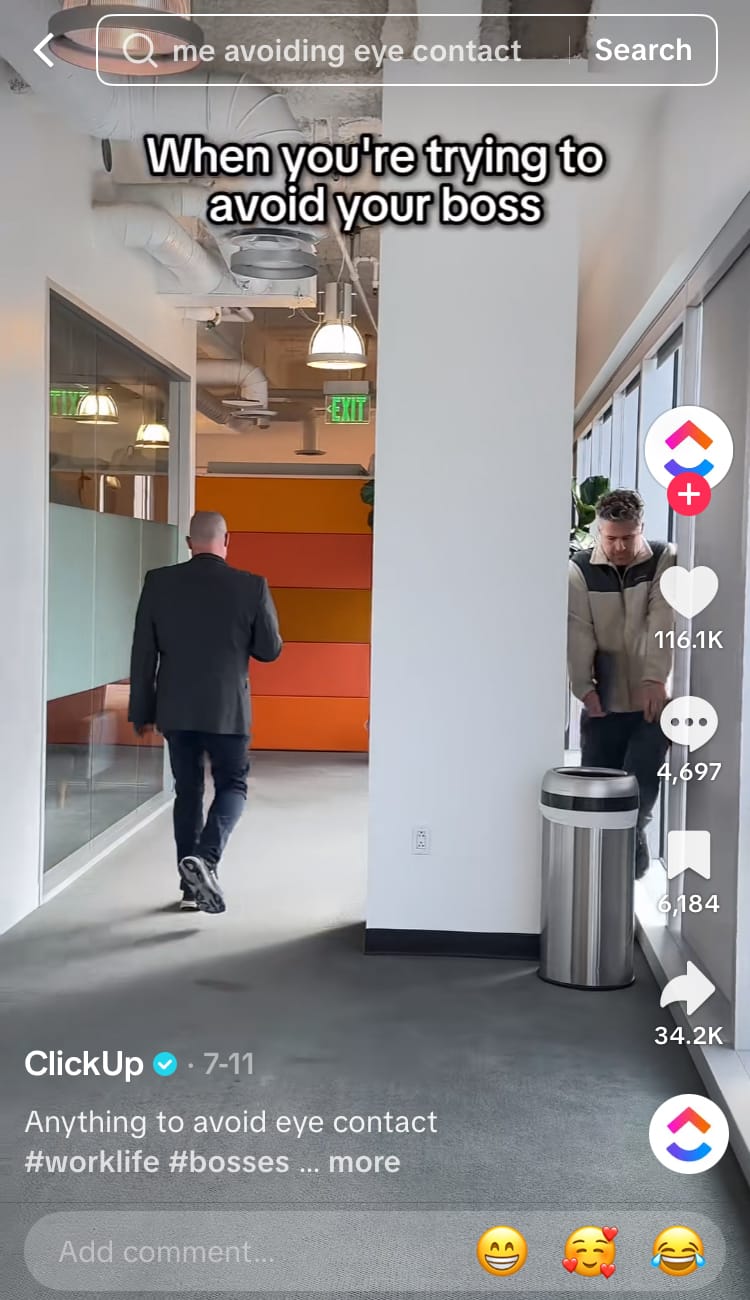
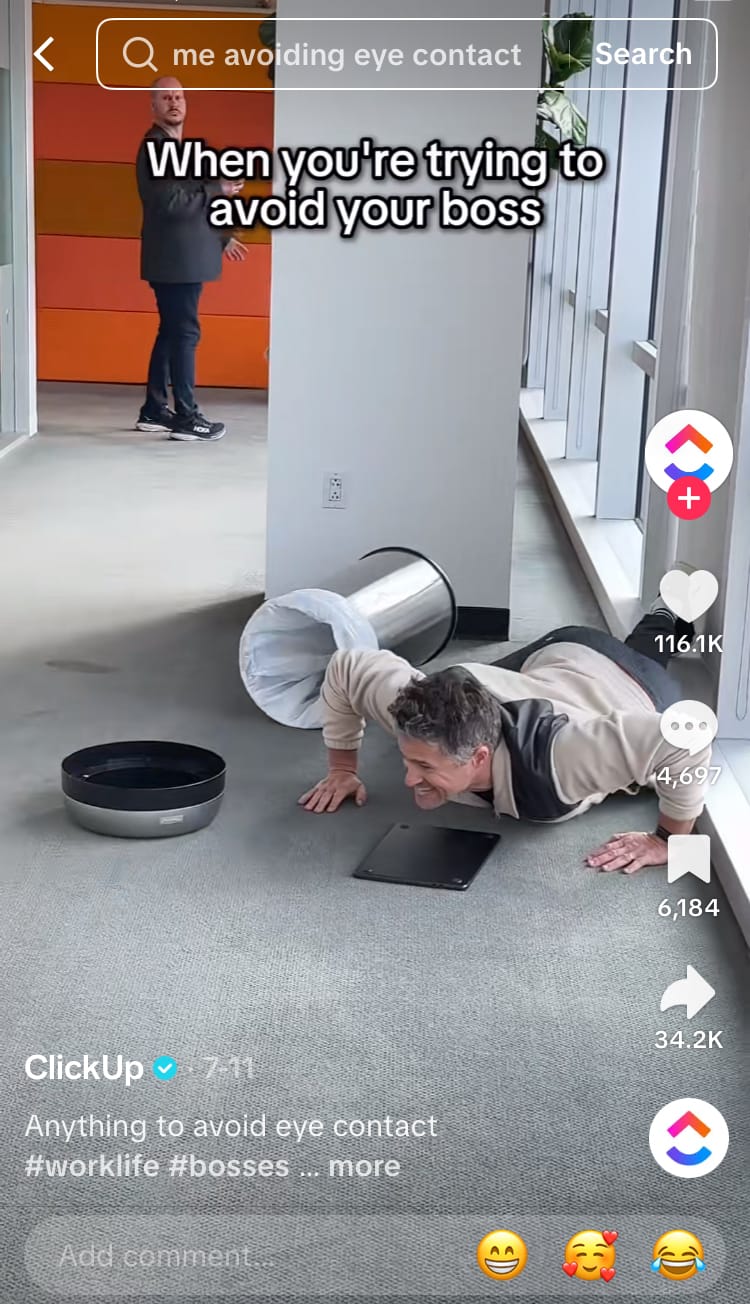
TikTok videos by ClickUp
ClickUp leaned heavily into corporate humour, incorporating skits about casual Fridays, corporate jargon, personality types from specific office departments and funny scenarios. It aimed to poke fun while keeping it real, sparking relatability as well as laughter.
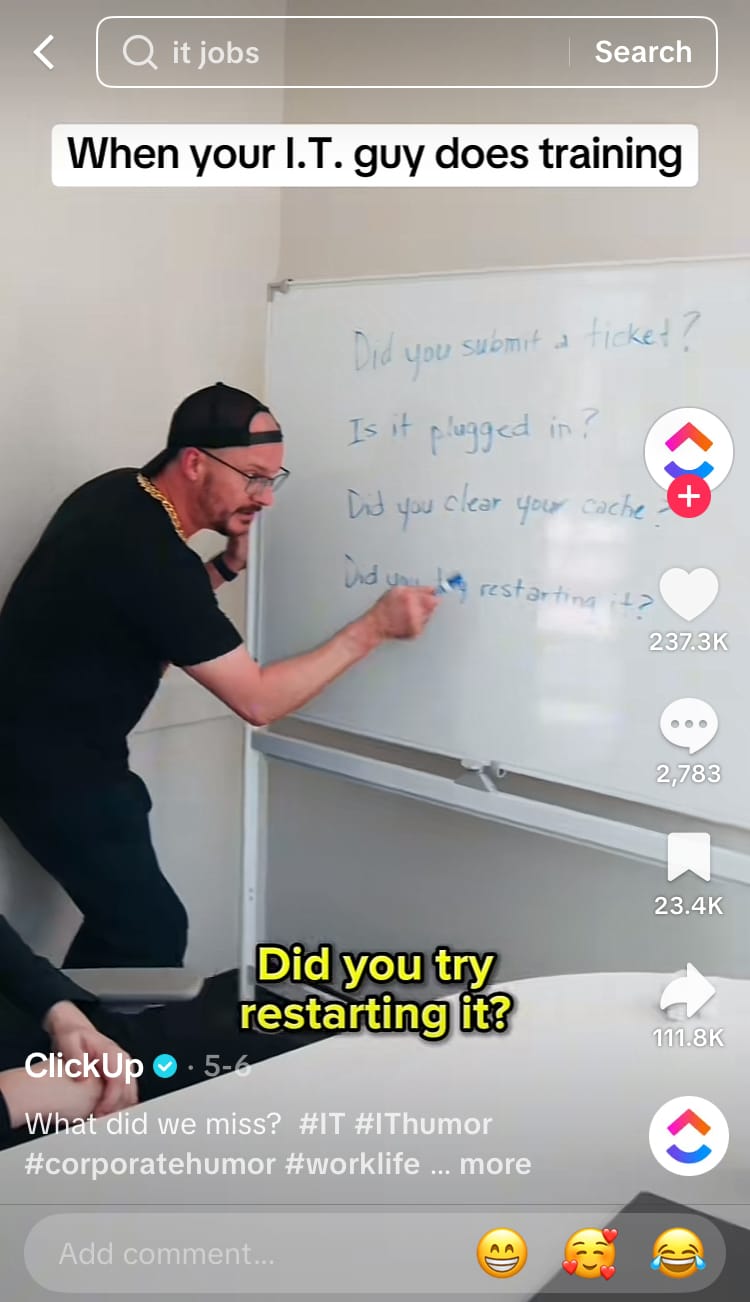
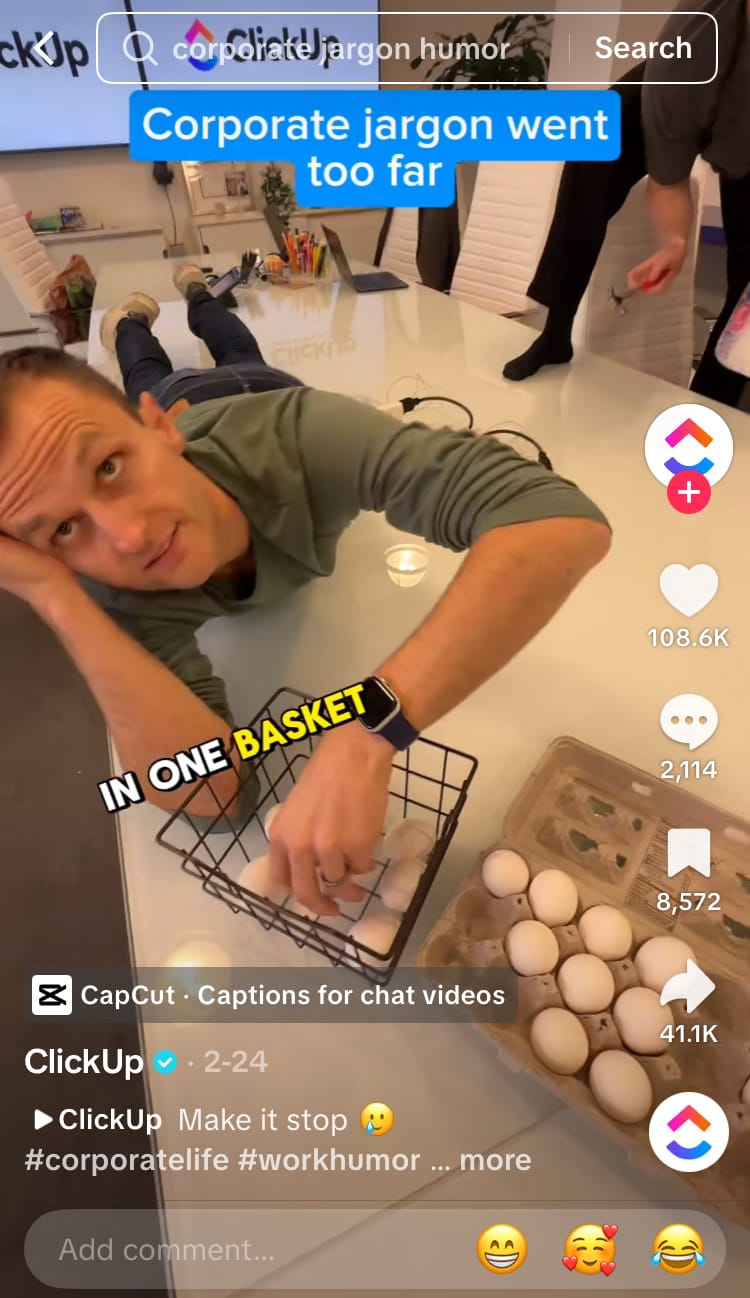
TikTok videos by ClickUp
And of course, there was the occasional pop at the working relationship between Gen Z and Millennials for good measure.
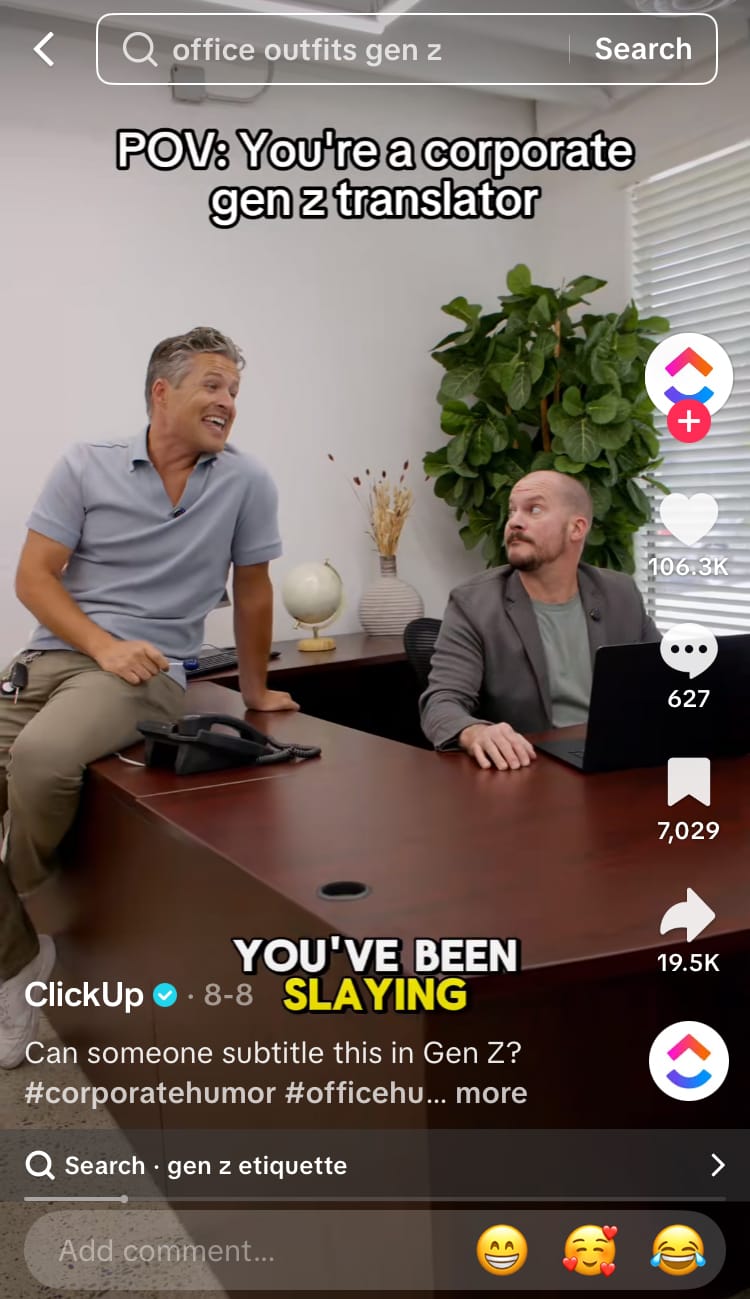
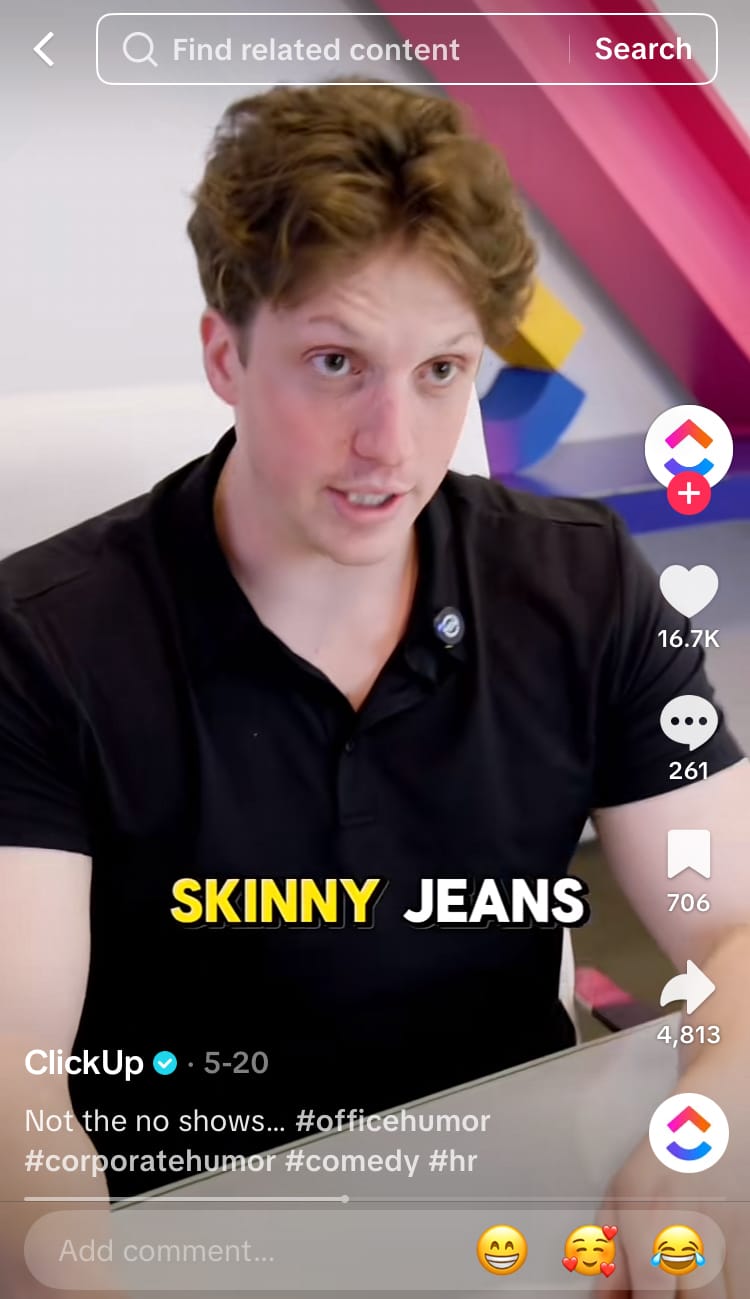
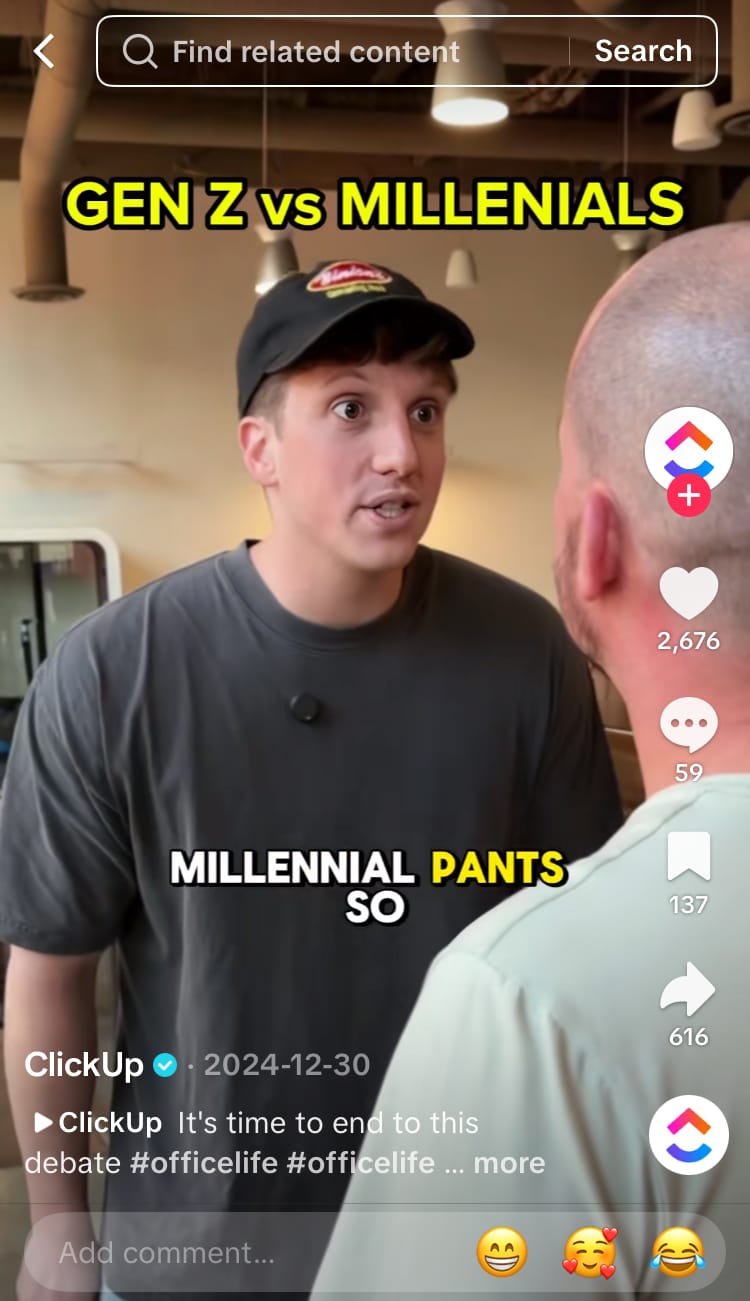
TikTok videos by ClickUp
Problem 3: Inconsistent branding
One problem that stopped ClickUp from gaining traction on TikTok was an inconsistent approach to branding. This meant that even when ClickUp saw a spike in action on a TikTok video, viewers couldn’t recognise the brand the next time they saw it.
Branding isn’t simply about stamping your business logo all over your content. It’s about building recognisable elements into your content so that the people who love what you do can recognise new content when it appears in their feed, search and explore. It’s also a tool to help a business stand out in a feed full of other content.
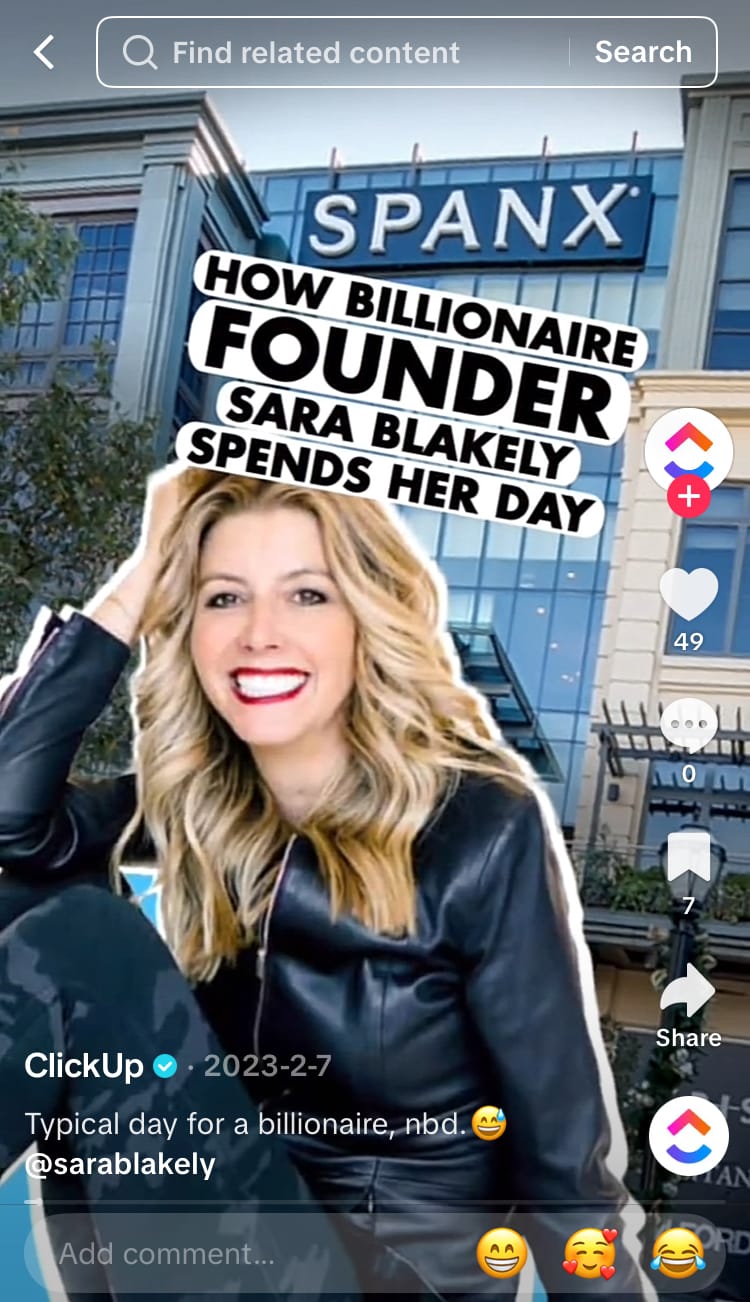
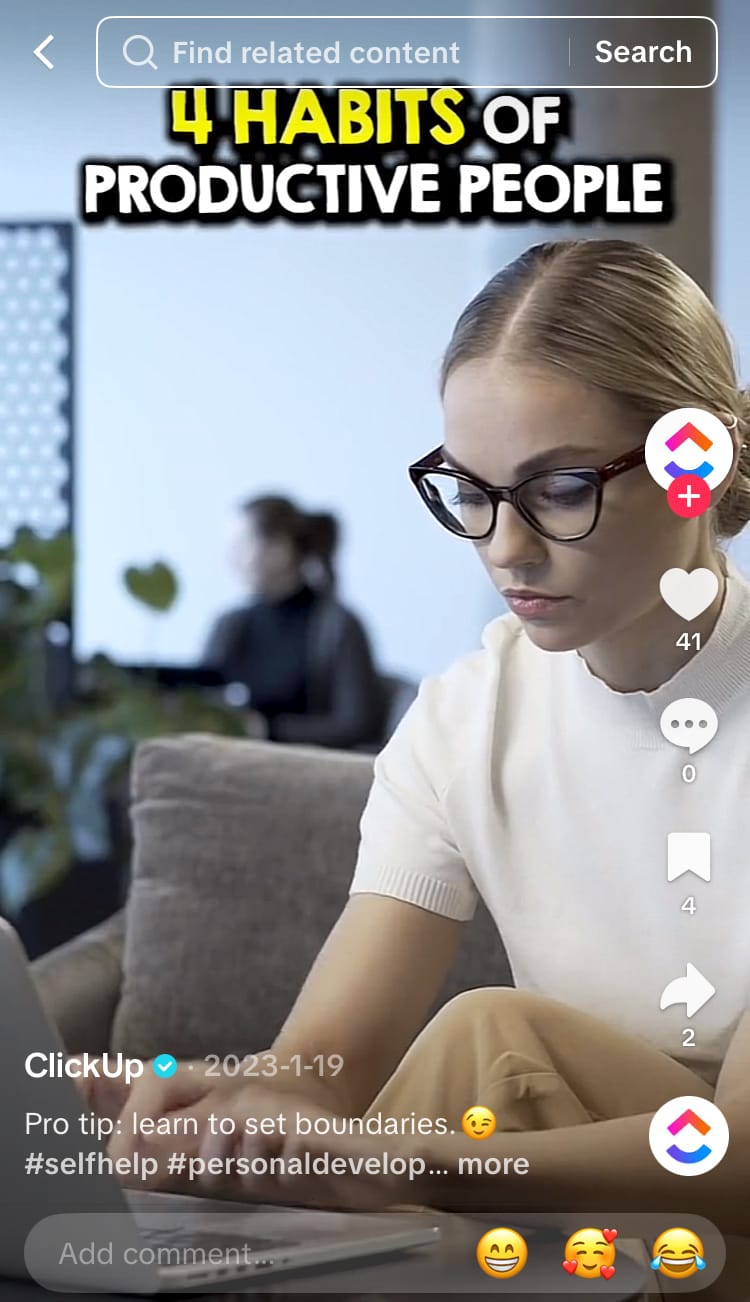
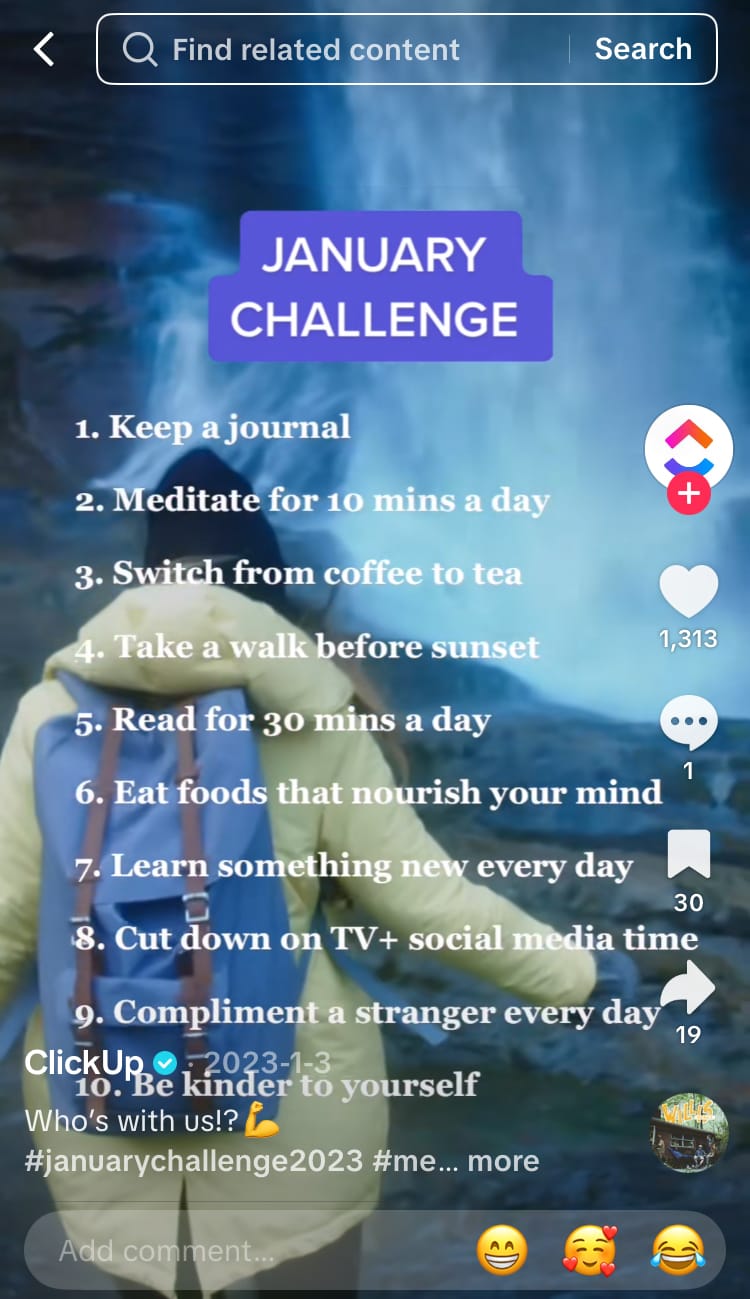
TikTok videos by ClickUp
Take a look at the examples above. Notice how the text varies and includes different colours, fonts, capitalisation and placements across different videos. Notice how each example features a different person and that each person is presented differently. Would you instantly know that these three pieces of content are from the same brand without looking at the profile logo? This is an example of why consistent branding is so important, and how the lack of it makes it difficult to recognise a brand.
Solution: Repeat what works
ClickUp copied several elements from videos that hit to turn one-hit wonders into multi-part series. By doubling down on what worked, ClickUp built some seriously solid branding and started its TikTok success rolling.
The first thing that was a consistent hit for ClickUp was its skits on various corporate job roles and the wishy-washy way people describe what they do. From project, product and sales managers to CEOs, ClickUp said what everyone else was thinking: that no-one really knows what these people do - not even the title holders themselves.

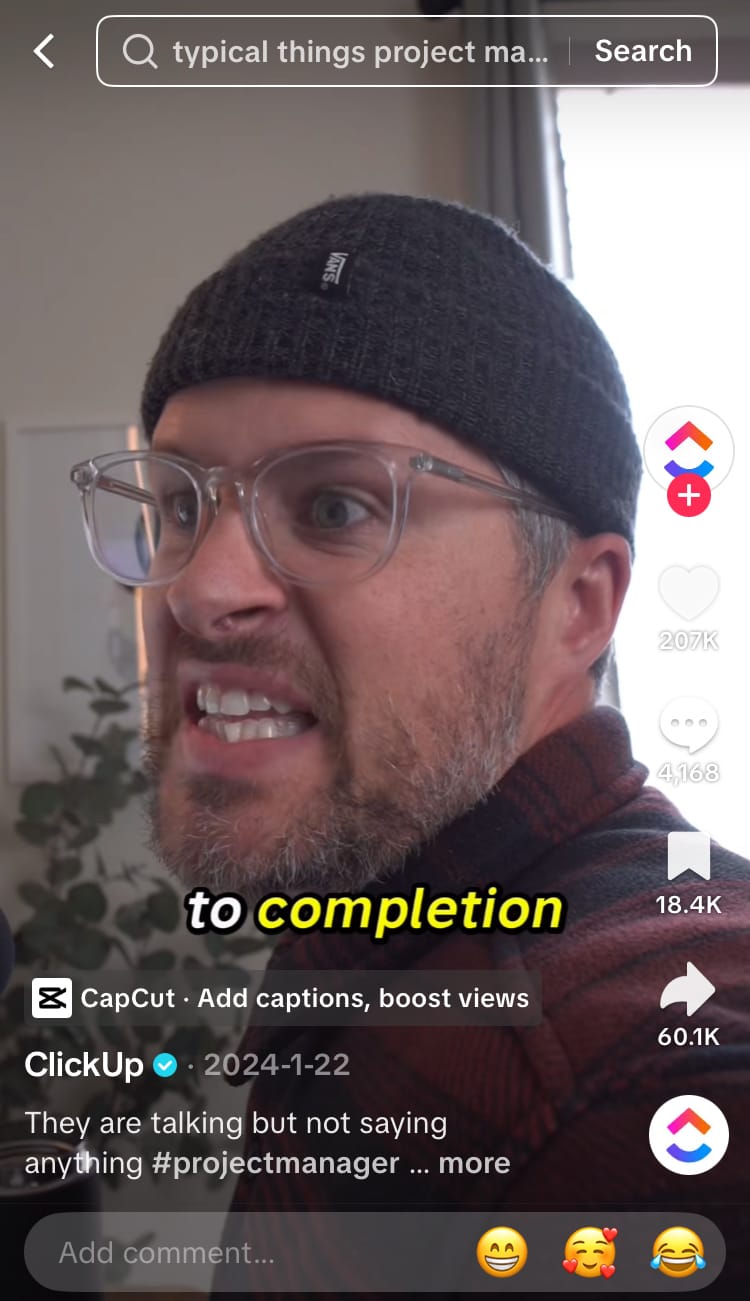
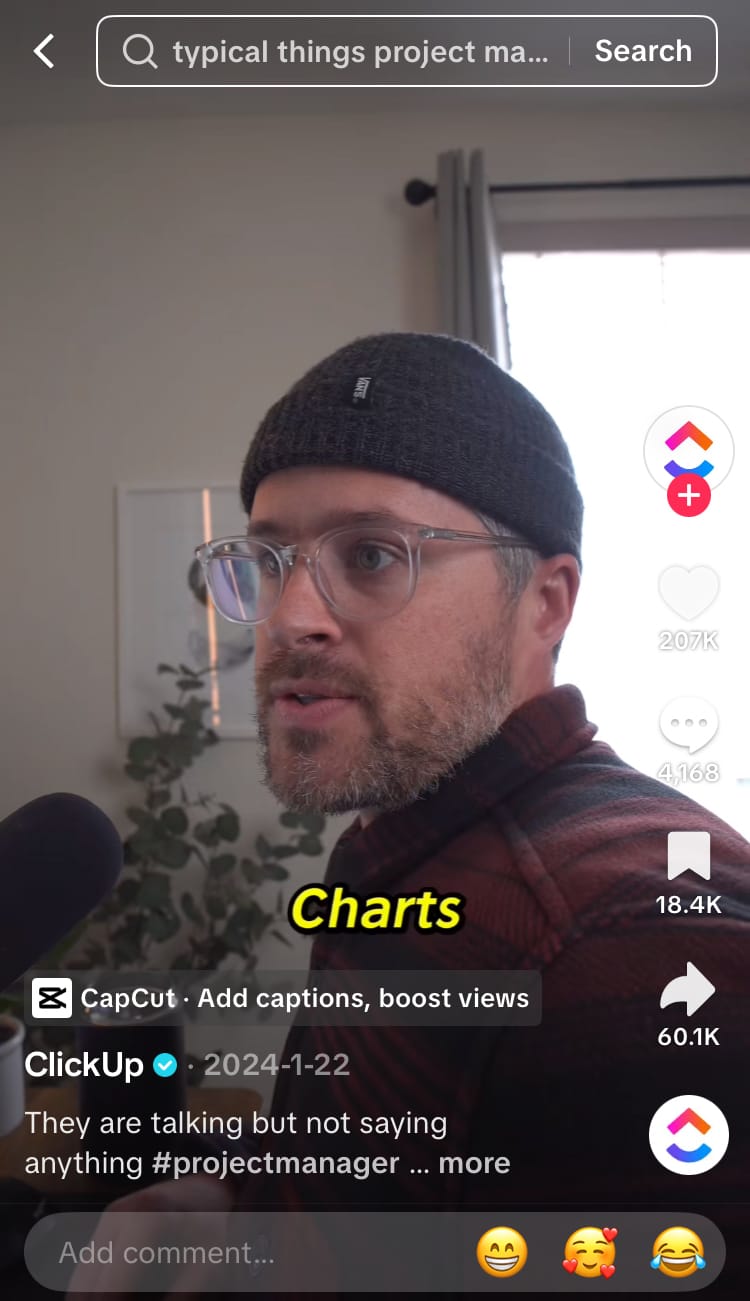
TikTok videos by ClickUp
With its newly-found focus and clarity around its target audience, ClickUp repeated this approach with other skits that became a hit. ClickUp made several videos with the theme ‘when your coworker is as weird as you’ which highlighted themes of friendship, fun and silliness in a heartwarming string of scenarios.
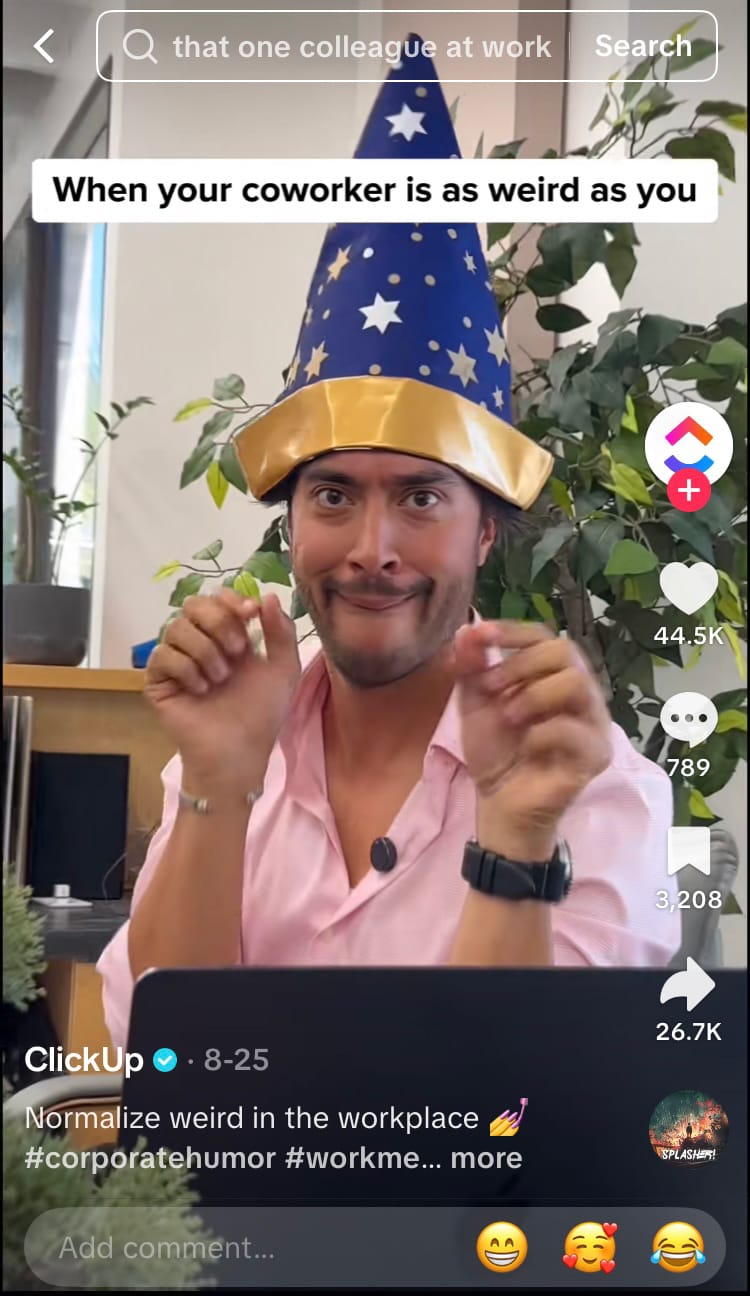
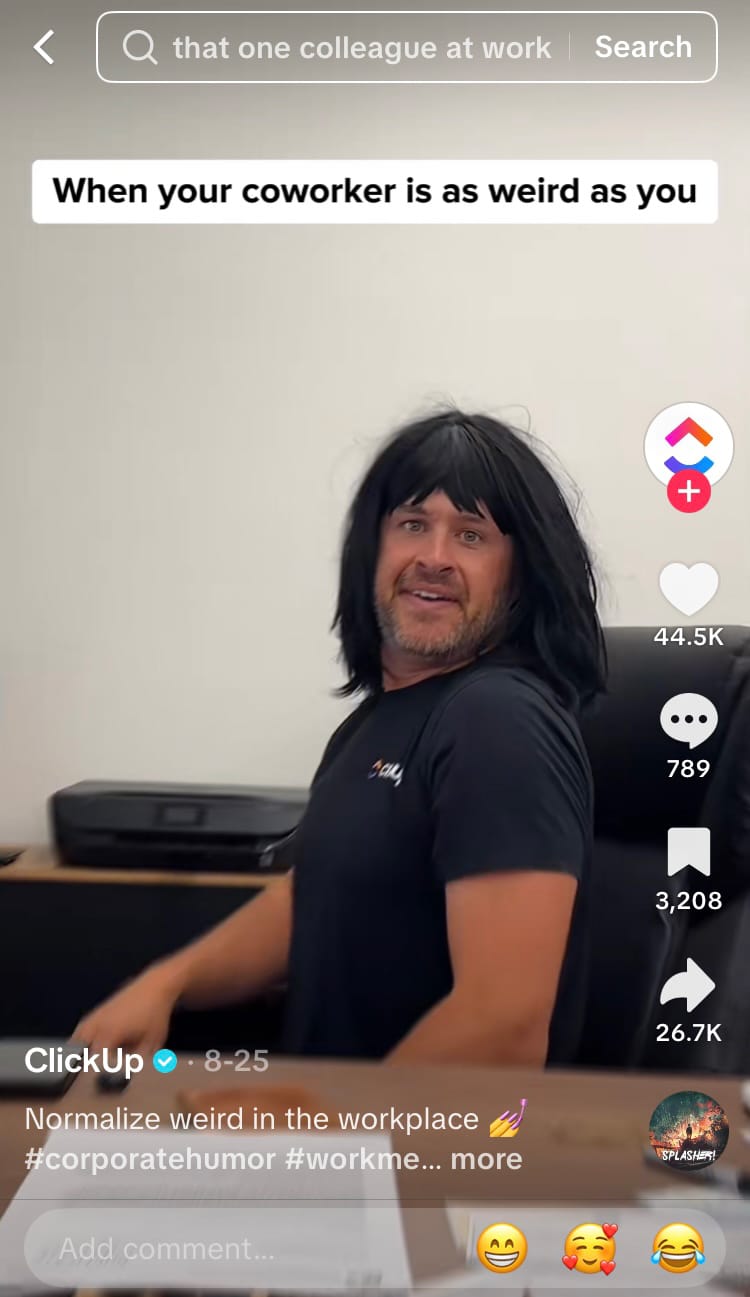
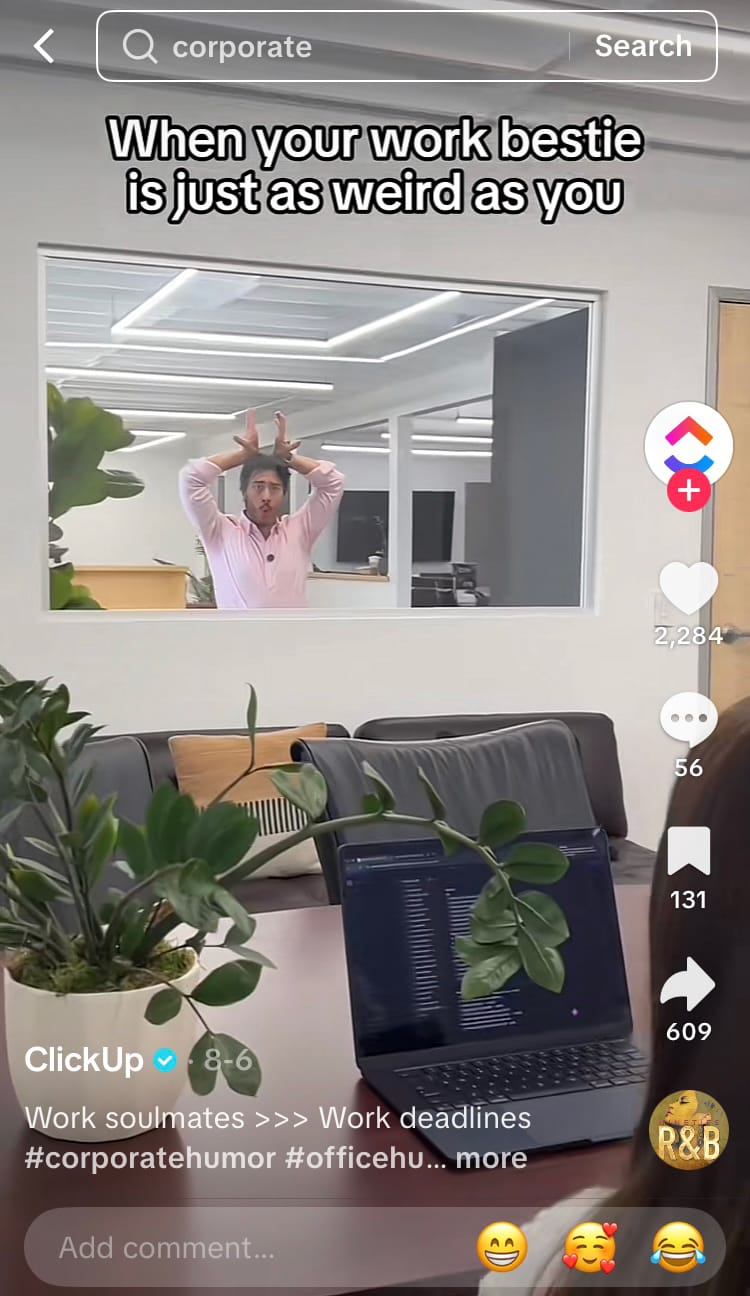
TikTok videos by ClickUp
ClickUp also wrote corporate covers of well-known songs and performed them with the gusto of a kid at a talent show. Green Day, Whitney Houston, Jamiroquai and Eminem were just some of the lucky stars to get makeovers of some of their biggest hits.
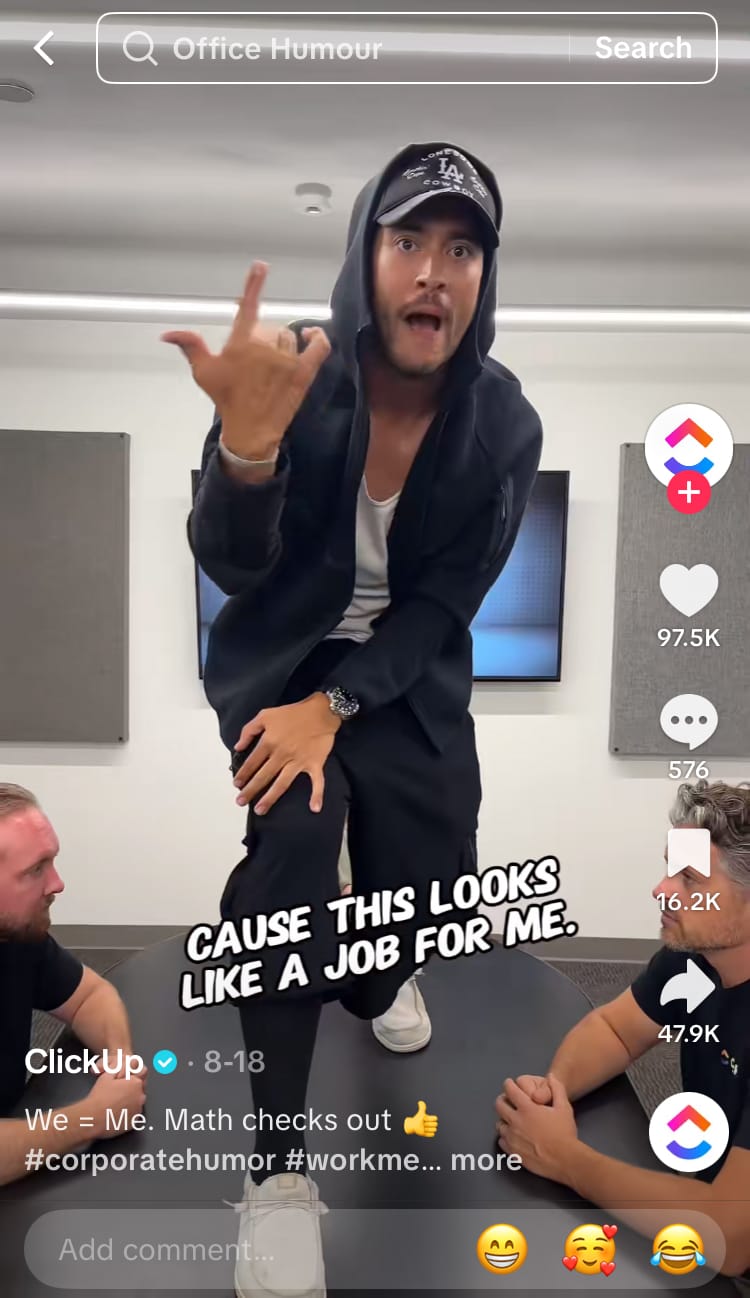
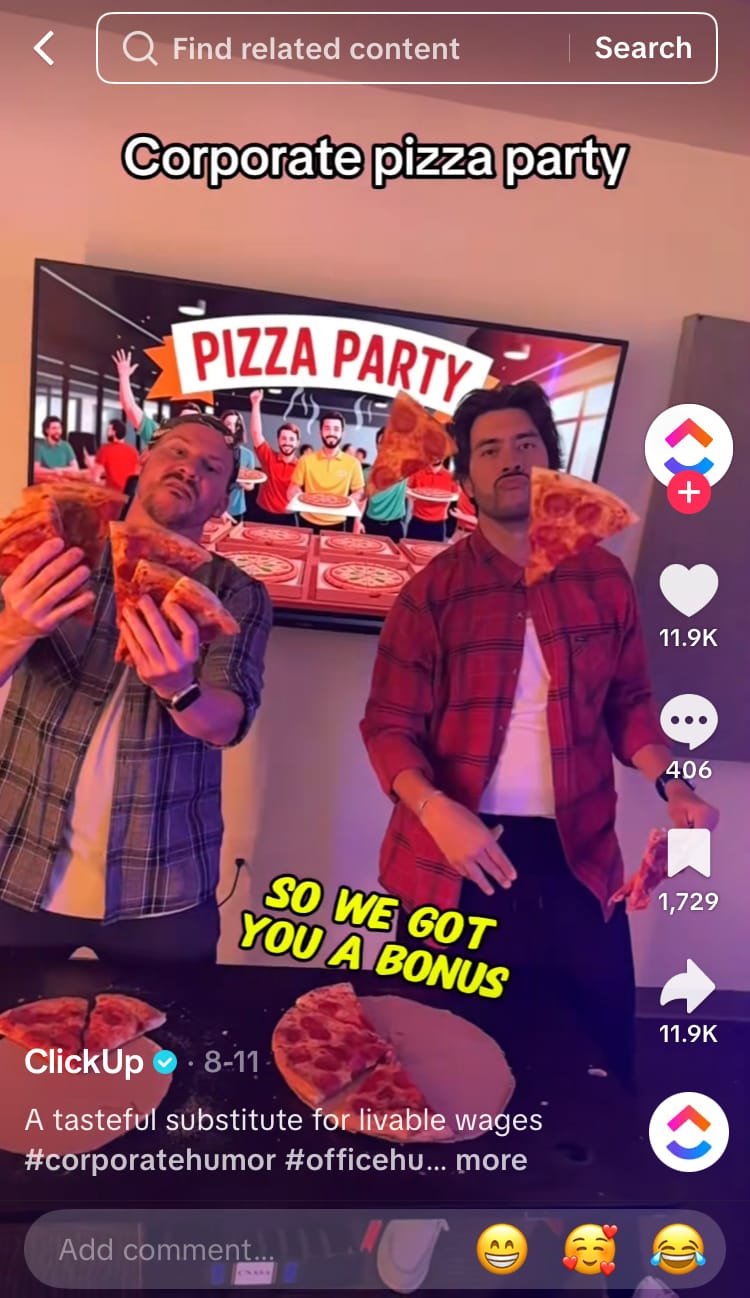
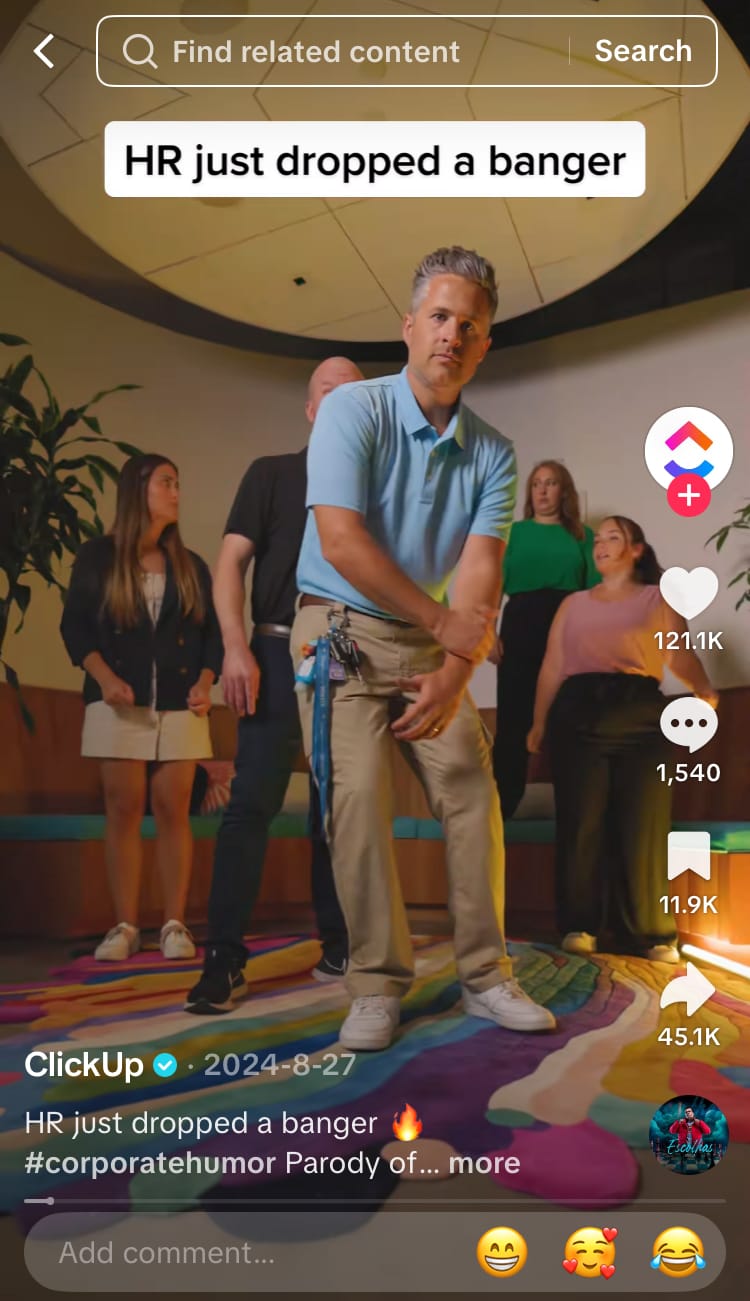
TikTok videos by ClickUp
ClickUp repeated several elements across its top-performing TikTok videos including:
- Honing in on skits
- Using the same video layouts
- Having the same person/people in the videos
- Writing similar characters into sketches
- Always including humour
- Having similar content themes
- Overlaying text in the same fonts, colours and locations on the screen
- Going straight into the action
- Adding a title overlay at the beginning of the video
- Ensuring there is a light-hearted tone
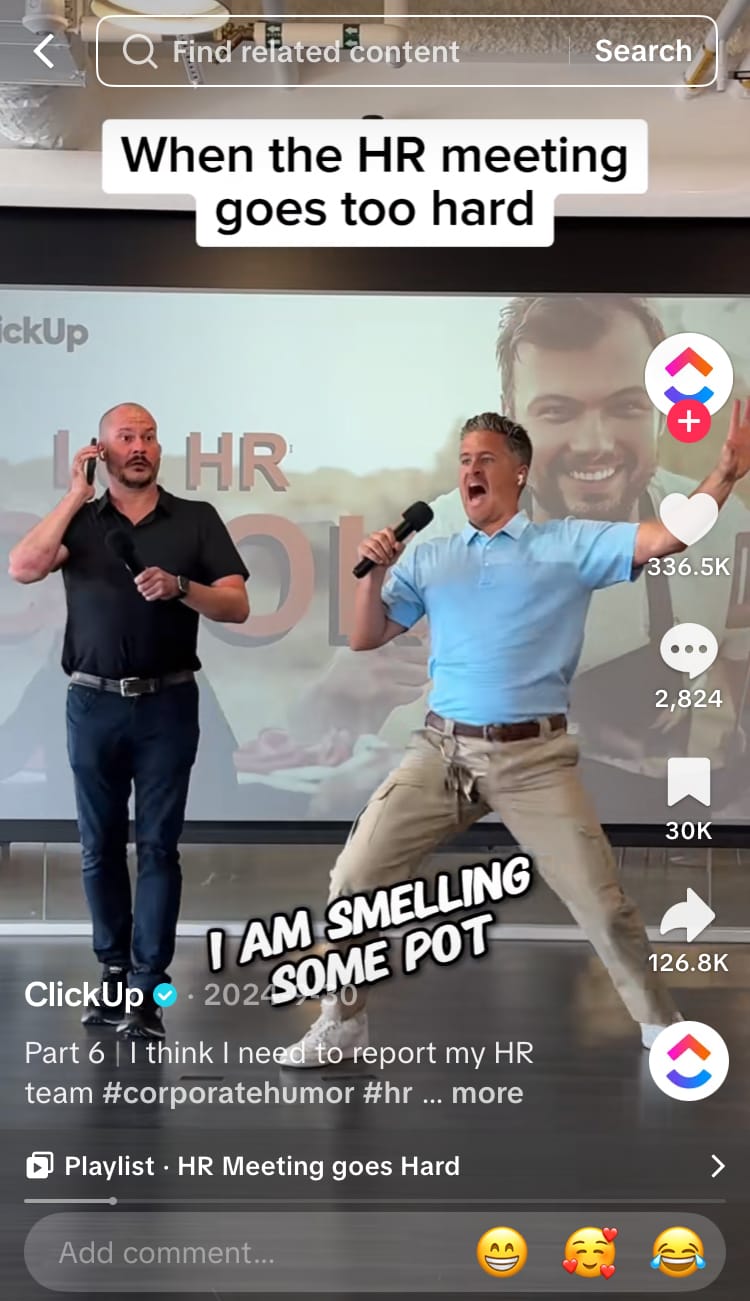
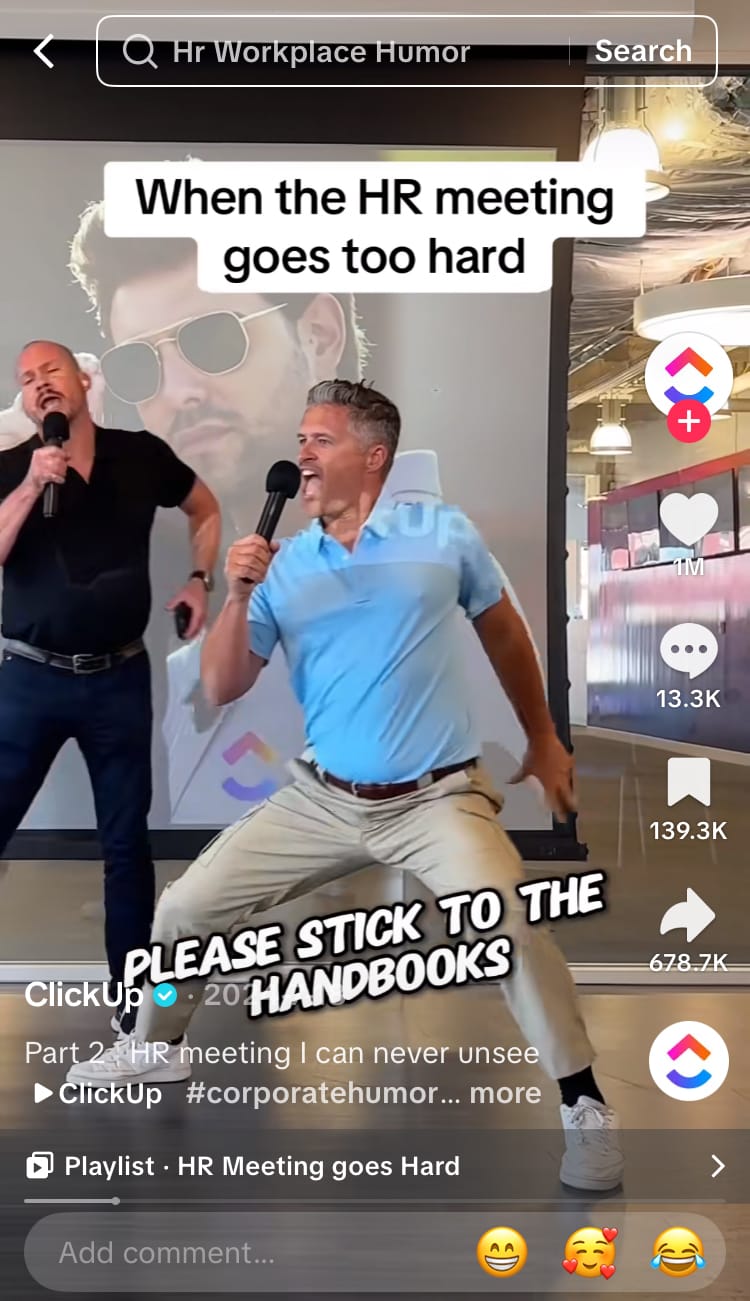
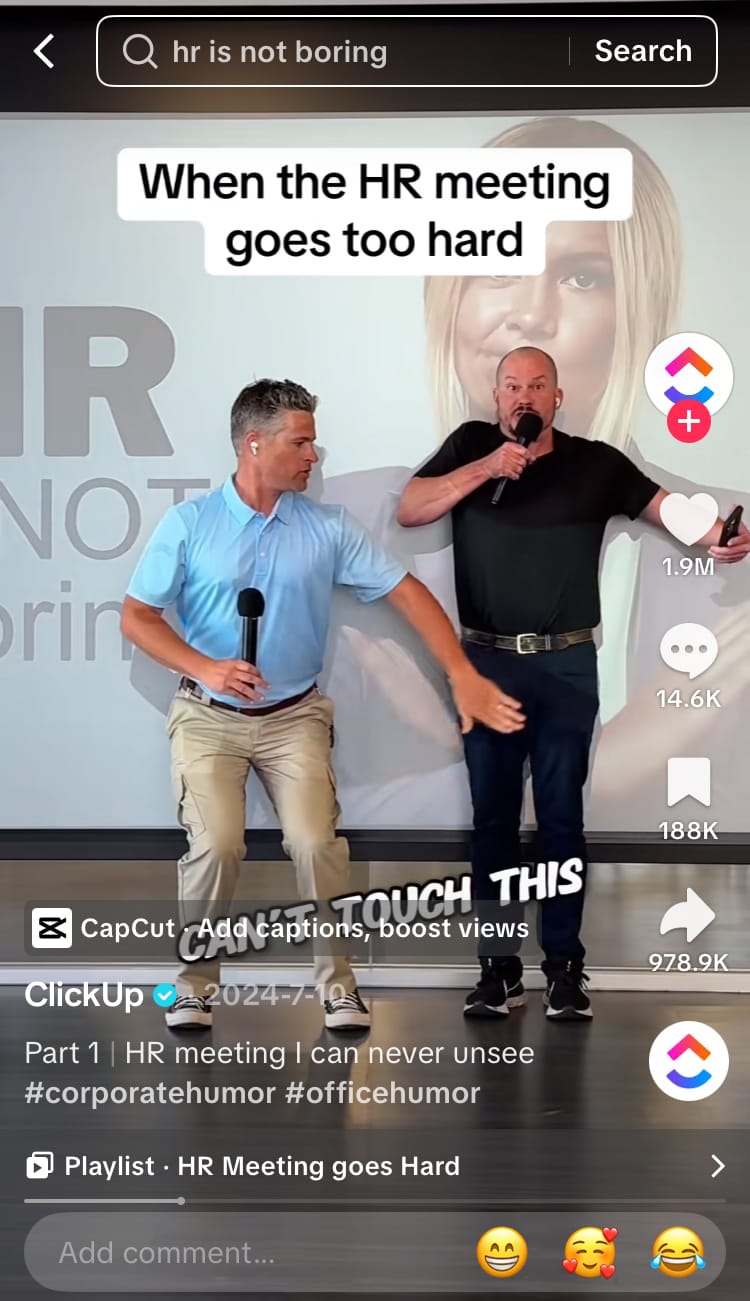
TikTok videos by ClickUp
Notice how obvious it is that the three examples above are from the same brand. But ClickUp didn’t limit itself to only one type of sketch. Instead, ClickUp created familiar characters, ideas, topics, tones and jokes to allow the brand and its content flavours to expand while making it clear that the content was from the same company.
With these 3 key elements in your TikTok strategy, you can get the ball rolling towards higher levels of reach, engagement and follower growth. To get a clear picture of your current audience, levels of engagement and top-performing posts, as well as access to the AI Analyst, head to Minter.io - the social media analytics tool for businesses looking to grow online.
Try Minter.io now to get the knowledge you need to grow faster and more effectively on social media.
Try Minter.io!

